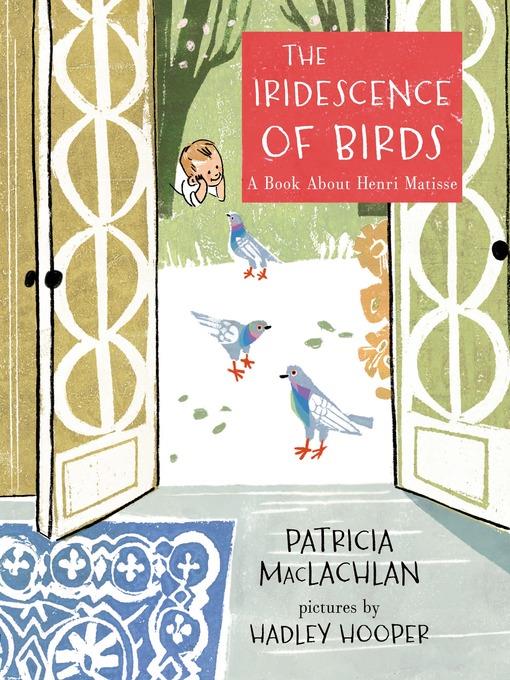
The Iridescence of Birds
A Book About Henri Matisse
فرمت کتاب
ebook
تاریخ انتشار
2014
Lexile Score
470
Reading Level
0-2
ATOS
2.6
Interest Level
K-3(LG)
نویسنده
Hadley Hooperناشر
Roaring Brook Pressشابک
9781466876644
کتاب های مرتبط
- اطلاعات
- نقد و بررسی
- دیدگاه کاربران
نقد و بررسی

Starred review from August 18, 2014
In one long, singing sentence (and a briefer second one that’s no less lyrical), MacLachlan (Snowflakes Fall) takes what’s known of Matisse’s upbringing and shows how naturally it leads into a life as an artist. “If you were a boy named Henri Matisse who lived/ in a dreary town in Northern France where the skies were gray,” she starts, as Hooper (Here Come the Girl Scouts!) draws a bundled-up boy crossing a village square in the wintry dusk. As MacLachlan shows how Matisse’s mother brought color into her son’s life, Hooper’s woodcutlike images recall Matisse’s organic forms and brilliant hues while preserving her own style. Small Henri feeds pigeons, “Watching... their colors that changed with the light... That your mother called iridescence.” On the next page, the boy stands opposite the man Matisse, who holds a palette. “Would it be a surprise that you became/ A fine painter who painted/ Light/ and Movement/ And the iridescence of birds?” It’s a sumptuous meditation on the way artists see and feel, one that possesses an iridescence of its own. Ages 4–8. Author’s agent: Rubin Pfeffer, Rubin Pfeffer Content LLC. Illustrator’s agent: Marlena Agency.

Starred review from September 1, 2014
If indeed the "child is father to the man," Newbery medalist MacLachlan's poetic, careful and concentrated text captures the essence of Matisse's childhood experiences and draws powerful parallels with his later life and work. In her second picture book, Hooper (Here Come the Girl Scouts, by Shana Corey, 2012) employs a relief-print process with digital enhancement, art that is a perfect match for the simple story's vivid imagery. Effective page turns and the accretion of detail in both text and illustration take readers on a journey from perennially overcast northern France to the patterned interiors and lush exoticism of Matisse's Provence while demonstrating the artistic beginnings of his fauvist palette. It modulates from spread to spread, from the "dreary town in northern France" where the skies and streets are gray, through the exciting, paint-filled pots of color in Matisse's mother's china-painting studio and the oranges and golds of fruit and flowers from the markets to the many shades of reds in the rugs his mother put on the walls and floors of their house. The title springs from Matisse's love of pigeons. He was fascinated by their "sharp eyes" and "red feet." And he particularly loved watching their colors change as they moved-the titular "iridescence." Raising pigeons, it seems, was the perfect pastime for this quiet, color-loving boy who would become a brilliant painter. Glorious. (biographical note, artist's note, further reading) (Picture book/biography. 4-8)
COPYRIGHT(2014) Kirkus Reviews, ALL RIGHTS RESERVED.

Starred review from August 1, 2014
Gr 1-4-This richly textured picture book looks at Henri Matisse's inspiration as a young boy, beginning with a spread depicting the gray, clammy French village in which he grew up. But while it is cold and damp outside, Matisse's mother fills the interior of their home with light through pattern and color. She paints natural scenes on plates, allows her son to mix and experiment with paint, and covers every possible surface with color. They are surrounded by their art. This look at Matisse's creativity and artistic process is strong and unusual for several reasons. Maclachlan concentrates on Matisse's mother and her influence on his eventual career. Her poetic text doesn't give the specific details of the man's life, but readers come away with a real sense of his art. Hooper's art, a combination of relief printmaking and digital techniques, expands readers' understanding of the text. They have strong solid lines, contrasting with the wide range of pastel colors. Hooper isn't derivative of Matisse's style but rather takes his tools and creates something new. On one spread, the background features a piece of Matisse's art; careful viewers will notice the artist in the foreground, growing from a boy into a man. The book gives off a creative energy that readers of all ages will find fulfilling. The simplicity of the text makes this book appropriate to use as a springboard to Matisse's work for even the very young. A poetic look at creativity, both natural and nurtured.-Susan E. Murray, formerly at Glendale Public Library, AZ
Copyright 2014 School Library Journal, LLC Used with permission.

Starred review from June 1, 2014
Grades K-3 *Starred Review* Could an essential, spirited picture book capture the brightness of a childhood that inspired a lifetime of genius? In two long, lyrical sentences, MacLachlan wonders about the early years of Henri Matisse, who grew up in a cold, gray city in northern France and was warmed by the colors of the paints, fabrics, and birds that surrounded him. Posing her thoughts as questions, MacLachlan distills Matisse's first experiences, assembling them in rough detail to communicate their emotional impact, much like the Fauvist master her subject became. Hooper's vivid block-print illustrations vibrate and hum, echoing Matisse's lively sense of dynamic composition and brilliant color. In expansive spreads that fill the pages, she shows us a boy who thrilled to his environs, especially their hues, patterns, and iridescence. A central spread has young Henri climbing a ladder on the left while his grown self stands on the opposite side, demonstrating inspiration that has been realized. Thereafter, the child and adult Matisse occupy the pages together, sharing the space, now filled with the artist's iconic imagery, and fulfilling their communal promise. Endnotes by the author and illustrator illuminate the depth and specificity of their research and suggest further reading.(Reprinted with permission of Booklist, copyright 2014, American Library Association.)

























دیدگاه کاربران